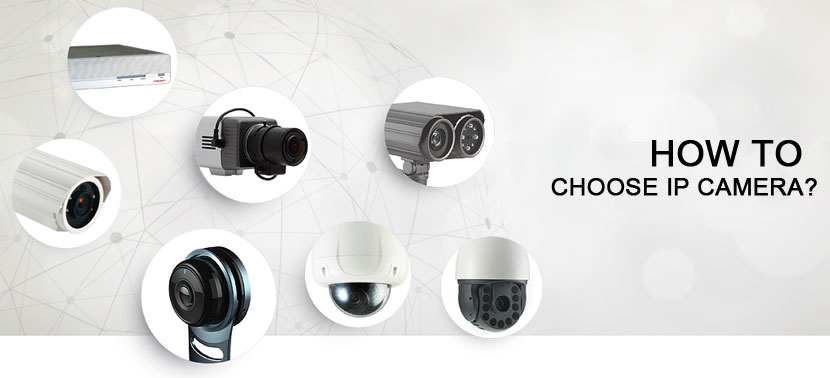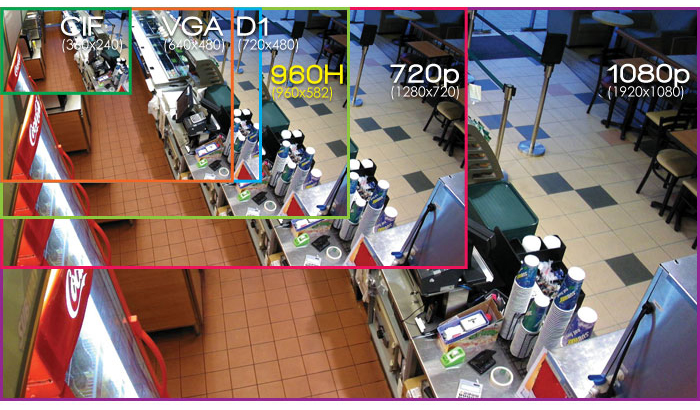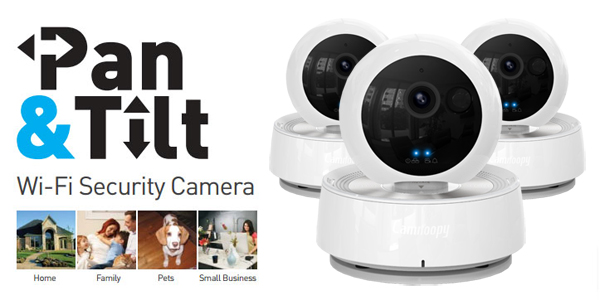
How to choose IP camera for home?
I know you may read many articles about this topic, but I'd like to share my some thoughts on this selection of IP cameras. Choosing the appropriate IP camera including many factors. IP cameras are widely used in many fields including industrial, military, civilian...etc. Today, we are going to narrow its scope, and merely discussing the selection of IP cameras for home. No perfect solution, only good camera to meet your needs, let me share my thoughts.
#1. Indoor or outdoor surveillance
When choose the IP camera, you need to consider where the IP camera will be installed. Typically, Indoor IP camera is suitable for indoor video surveillance, hence these cameras are compact size with aesthetic design, which can be easy blend into your home decoration. For outdoor monitoring, you have to use the outdoor cam, since it has weatherproof (waterproof) design to resist rain, dust..etc. Outdoor camera is also can be installed indoor, but since almost outdoor IP camera with heavy-duty "Professional" design, which makes it so intrusive in your home.
#2. Do-it-yourself or professional installation
Will you install the camera by yourself? If you are going to install the IP camera by yourself, WiFi wireless IP camera is the ideal product to you. The second choice is PoE IP camera. WiFi means users can install the camera anywhere within wireless WiFi coverage. Without wired connection, just need to connect the power supply, your camera will start to work, but limited to short transmission distance is the setback for WiFi, the distance is much shorter when environment has barriers. For long distance, and house already had network infrastructure, PoE can be your choice. The advantage of PoE is camera only uses single Ethernet cable for both data and power supply transmission. Please note you need to use a PoE injector which is able to provide power supply (DC12V) to PoE IP camera.
In conclusion, WiFi camera is ideal for short distance, PoE is ideal for middle range distance. WiFi camera is really easy to setup product for Do-it-yourself installation, PoE or Non-PoE cameras are ideal for professional installation. Wired connection is the most reliable way to transmit video signal. If you want to setup a complete surveillance system, WiFi IP camera isn't your choice.
#3. When consider the price, cheap or expensive?
Obviously, if I am rich, then I would like to choose expensive IP camera which has well-known brand name. High price equals high quality and service, generally this is true. For IP camera, since the rapid development of digital technology, many small manufacturers also have capability to produce good products with high quality. Typically, there is not too much differences between a cheap IP camera or expensive camera. If you want to buy a cheap IP camera, you may follow these tips:
- 1. Comparing the hardware performance such as resolution, viewing angle, video storage, smart video analysis.
- 2. Before purchasing the product, download the software to check its web-interface and App UI design.
- 3. If possible, asking for a demo.
- 4. Considering the warranty and after sales.
#4. Do you want to record video footage?
I know almost all IP cameras can allow user to save the video footage. But I have realized that outdated IP cameras are stilling selling on market, you may want to buy one since they are extremely cheap. Taking 300,000 pixel IP cameras, these cameras definitely can record the video and upload to FTP server. For video recording, protocol or standard is required. When buy the camera, read its specification carefully, and check whether it supports Onvif or RTSP protocol. Generally, an Onvif compliant IP camera is much expensive than traditional IP camera.
#.5. Considering resolution, 0.3MP, 720P or 1080P
As we know, the higher of the resolution, the better of the image quality. In my personal opinion, 0.3MP is outdated, and it's provide you maximum a VGA format resolution which is 640x480. If you only want to watch the live video through your smartphone, I think this resolution can meet this requirement, but 720P is the trend and this resolution provides 1280x720 high definition video. Why don't I recommend the 1080P? Except the resolution, you also need to realize that network video streaming occupy your network bandwidth. Although 1080P can provide you full HD video, it also requires much higher network bandwidth. One 1080P IP camera will occupy approximate 4Mbps bandwidth. For smooth video streaming, 720P IP camera is good choice.

#6. Is the camera expandable?
In the past, IP camera is designed for video monitoring. Now things have been changed with rapid technology development. People want the IP camera can work smartly, they require the camera can analysis video such as detect motion, or object missing, mask...etc. For system integration such as connects to alarm system or access control, home automation system, Alarm I/O (input/output) is the current solution for IP cameras. Now let me introduce our IP camera -Erobot, which adopts complete different method to achieve smart home security. Different from other IP cameras, this camera has wireless RF design, which enable camera can work with wireless intrusion detection sensors. This function enable user not only watch live video, but also passively protect your home like a home alarm system. When you leave home, you just need to arm the IP camera through your smartphone App or remote controls. Once window or door breaks-in, you will receive alarm notification that tells you where is the sensor triggered.
#7. Day or night surveillance?
Certainly, you want the camera watch your home at day/night. A day/night IP cam can provide you color images at day, and B/W (Black and White) images at night. What does make camera see at night? Typically, similar to our human eyes, camera also can't see under complete darkness. The camera utilizes infrared illuminator to help them see at night. Infrared light is invisible light for human being, but image sensor can see, with this feature, it becomes ideal light sources for cameras. How far the illumination of Infrared determines the night vision range. For interior protection, the night vision range shouldn't less than 5 meters, 10 meters is the minimum range for outdoor monitoring.
IR-CUT (ICR) filter is used to block unnatural light enter into camera at day for offering you true color reproduction images.
#8. When consider the viewing angle
What's the coverage of surveillance? A 3.6mm fixed lens can provide you approximate 72 degree field of view, it can cover the whole lobby. What if you want to cover much larger area? An IP pan/tilt camera is the solution. Touch the video, you can rotate the camera in 355 degree horizontally or 120 degree vertically, all the things are under your surveillance. In conclusion, a traditional 3.6mm IP camera is qualified as a baby or pet monitor, but a Pan/Tilt camera can make feel more secure.
A zoom lens can also allow you zoom in and zoom out, but put a zoom lens into camera will increase dimension of camera, this the reason why you can find many IP PTZ cameras for outdoor, but few models for indoor.

Apparently, there are many aspects I haven't mentioned on this topic. I planned to list ten, but..... If you want to implement this list, please share your thoughts on below comment column. To help understanding this article, I listed the glossary for IP camera.
Internet Protocol
IP is the abbreviation of Internet Protocol, it's principle communication standard for data transmission between two or more than two IP devices. It's the essential component to establish Internet. Analog camera transmits analog video signal (uncompressed raw) through coaxial cable. IP camera broadcast digital video (compressed) over Internet.
WiFi
WiFi is one of network connection method which is based on IEEE802.11 standard. WiFi can allow two or more than two IP devices communicate each other to share data. WiFi is wireless transmission function that eliminates the wired cable (typically Cat5/6, Ethernet cable) for network transmission. In IP camera, it can allow user to setup a complete wireless video surveillance system, which in turn, greatly reduced the installation cost and maintenance fee. WiFi uses 2.4 GHz UHF and 5 GHz SHF radio waves.
PoE
Power over Ethernet is a mature technology to enable IP devices receive power supply through single Ethernet cable. PoE has been used widely in VoIP, Wireless Access Point, and other network fields. It has two standards; IEEE802.3af, IEEE802.3at. IEEE802.3af standard offers maximum 15.4 W of DC power. IEEE802.3at (High Power POE+ Class) offers maximum 30 W of DC power, it's used in high power consumption devices such as IP PTZ camera.
CMOS
One of most popular image sensor, which widely used in megapixel IP cameras and DSLR camera, Cam-coder..etc. CCD is another type of image sensor. The difference between them; CMOS image sensor is cheap and its resolution can expand with increasing sensor's dimension. CCD is expensive and not easy to increase the resolution, having much lower image noise. CCD image sensor is used in analog camera through interlaced scan technology. CMOS is used in digital IP camera with progressive scan technology. Progressive scan can provide much clearer HD images to avoid motion blur.
HD
HD stands for high definition, it's one of standards in video broadcasting industry. Generally any video image with more than 480 horizontal lines (North America) or 576 lines (Europe) is considered high-definition. 720P is HD resolution which offers maximum 1280x720 resolution . 1080P is Full HD which offers maximum 1920x1080 resolution. HD is the current main stream in video broadcasting industry.
Onvif
For the purpose of increasing the compatibility among different manufacturer's digital security products, Axis, Bosch, Sony established global and open industry forum (Onvif) to exchange data, and hence created a standard to enable IP security device are compatible each other. In another word, Onvif compliant IP camera can works with cross brands software (video management software) and IP devices (NVR, NVS).
RTSP
The Real Time Streaming Protocol (RTSP) is a network control protocol designed for use in entertainment and communications systems to control streaming media servers. The protocol is used for establishing and controlling media sessions between end points. Clients of media servers issue VCR-style commands, such as play and pause, to facilitate real-time control of playback of media files from the server.
Get My Latest Posts
Subscribe to get the latest updates.
Your email address will never be shared with any 3rd parties.
Tags: IP Camera, Home Security